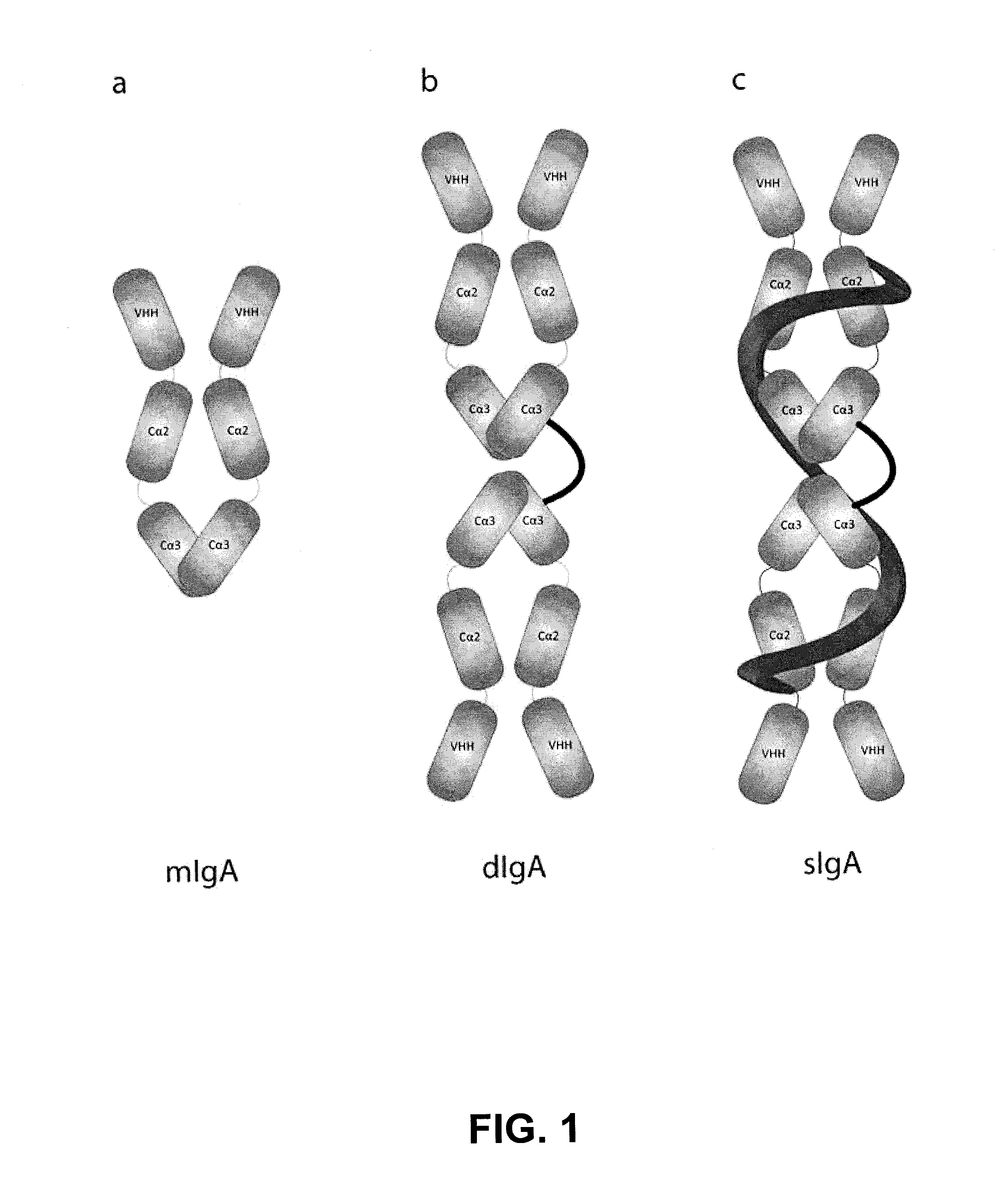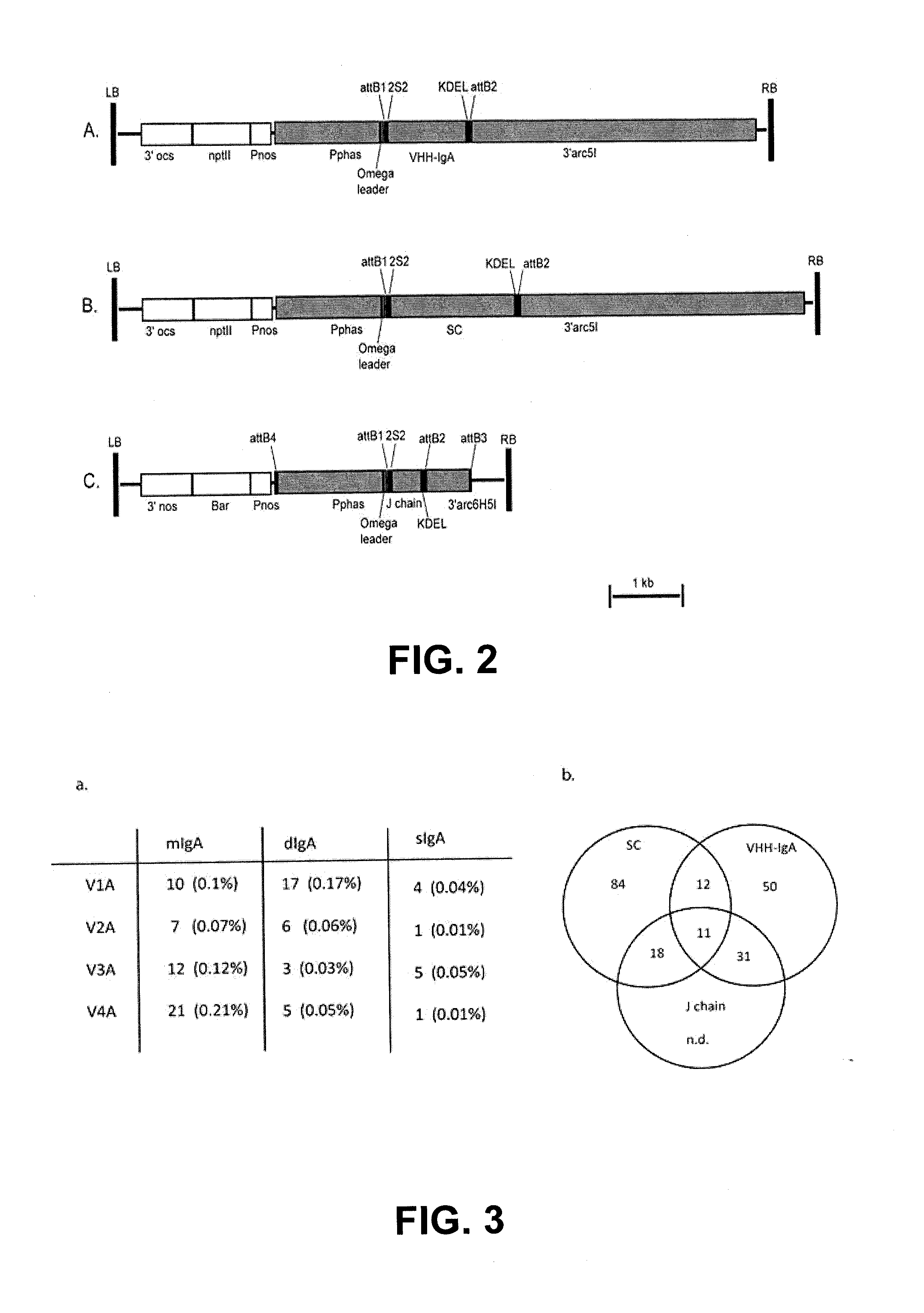Protective Anti-etec antibody
- Summary
- Abstract
- Description
- Claims
- Application Information
AI Technical Summary
Benefits of technology
Problems solved by technology
Method used
Image
Examples
example 1
Construction of VHH-IgA and VHH-IgG Fusion Proteins
[0032]Purified recombinant FaeGac was used to immunize a healthy llama. The cDNA library construction, phage display and panning procedures were carried out according to the standard procedures. Independent FaeG binding VHHs were selected by ELISA on plates coated with the antigenic variants FaeGac and FaeGad. Colonies corresponding to the VHH giving a positive signal in the ELISA screen were further tested by amplifying the VHH gene. Identical VHHs were eliminated using restriction fragment length polymorphism analysis (RFLP). Finally, four different VHHs were selected and sequenced. Those are indicated as V1, V2, V3 and V4.
[0033]In silico, the sequence of the Fc part of the porcine IgAb (Genbank U12594; version U12594.1, GI:555826) was optimized for expression in plant seeds, and fused at the carboxyterminal end to the DNA sequence of VHH V 1. Upstream of the VHH1 initiation codon, the EcoRI restrictions site, the Kozak sequence (...
example 2
Identification and Cloning of the Porcine J Chain
[0037]The amino acid sequence of the porcine J chain has not been published. However, given the overall genetic similarity between the humans and pigs, the amino acid sequence of the human J chain (NCBI reference sequence NM—144646.3; version NM—144646.3; GI:189491638) was used as bait to identify the porcine J chain by homology-based search against the porcine EST (expression sequence tag) database. The porcine J chain homologous gene was identified from the cDNA library made from porcine alveolar macrophages (Genbank AK231006: version AK231006.1; GI:115546487). Using BLAST-X, the J chain coding sequence was identified within this cDNA sequence, starting from the 72nd nucleotide (ATG) until the stop codon (TAA) at the 548th nucleotide.
[0038]The native signal peptide of J chain was identified using the prediction tool of Bendtsen et al. (2004), and this sequence was replaced by the signal peptide of 2S2 Arabidopsis seed storage protei...
example 3
Cloning of the Porcine Secretory Component
[0039]The Secretory Component (SC) is a proteolytic cleavage product of the polymeric immunoglobulin receptor (pIgR). Structurally, the pIgR has five extracellular domains that are connected to a transmembrane-bound region by a linker peptide. Cleavage in the linker region results in the release of the five domains bearing polypeptide, which is then either found as free SC or associated with dimeric IgA (dIgA).
[0040]The sequence of the porcine SC was derived from the published sequence of porcine pIgR (Kumura et al., 2000; NCBI reference sequence: NM—214159; version NM—214159; GI:47523405). Given that the first five domains of the porcine pIgR are important for wrapping around the dIgA, the first 579aa length-spanning region until the 5th domain after the signal peptide (corresponds to the 585aa of human SC) was selected and defined as porcine SC. The endogenous signal peptide of pIgR was determined using the signal prediction tool (Bendtsen...
PUM
 Login to View More
Login to View More Abstract
Description
Claims
Application Information
 Login to View More
Login to View More - R&D
- Intellectual Property
- Life Sciences
- Materials
- Tech Scout
- Unparalleled Data Quality
- Higher Quality Content
- 60% Fewer Hallucinations
Browse by: Latest US Patents, China's latest patents, Technical Efficacy Thesaurus, Application Domain, Technology Topic, Popular Technical Reports.
© 2025 PatSnap. All rights reserved.Legal|Privacy policy|Modern Slavery Act Transparency Statement|Sitemap|About US| Contact US: help@patsnap.com



